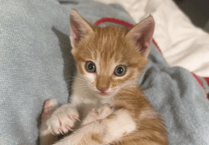It’s the time of year when we issue our annual Bonfire Night hedgehog alert!
If you’re planning your own bonfire then please remember that hedgehogs like to sleep in them.
The British Hedgehog Preservation Society’s advice is as follows: if the material to be ignited is stored on open ground in advance of having a bonfire, it’s crucial to dismantle it and move it to another spot just before lighting.
Please make sure your neighbours do the same thing.
If you do find a hedgehog (perhaps one that’s become frightened and curled up in a ball) place it in a high-sided cardboard box with plenty of newspaper and ensure there are air holes in the lid. Wear garden gloves so as not to get human smells on the hedgehog and to keep him or her calm as hedgehogs are easily stressed, and to protect your hands from the spikes. Put the box in a safe, quiet place such as a shed or garage well away from the festivities, and offer meaty cat or dog food and water in a shallow bowl (but definitely not milk because they can’t digest it). Once the bonfire is totally dampened down, release the hedgehog under a hedge or a bush.
Hedgehogs are not the only creatures to become stressed by bonfire night celebrations - the RSPCA estimates that 45% of dogs in the UK show signs of fear when they hear fireworks.
Most dogs have acute hearing which exacerbates the problem. You can help your dog, and any other pets you have in your house, by drawing all the curtains, playing soothing music, and providing extra bedding so that your pet can hide under it if necessary.
Make sure your pet is confined indoors well in advance of the festivities and ensure all doors, windows and cat flaps are closed/locked.
And don’t forget the pets you may have outside, such as rabbits and guinea pigs.
As well as providing extra bedding, partially cover their hutch or pen with a blanket but make sure your pet can still look out.
If you have a firework-phobic pet, a longer-term solution may be to try to de-sensitise them to acute noises.
You will need a suitable recording, or you can purchase specially-designed CDs, and by playing the sound on a low volume to begin with you can gradually introduce your pet to the noise. You can then gradually start to increase the volume.
We have two shy cats in our cattery at the moment, Toothie and Pazuzu, who will need a gentle introduction to everyday noises in their new homes, when they find them.
They’re both black cats, and so deserve a special mention because it was National Black Cat Day on October 27.
In the lead-up to Halloween/Hop Tu Naa, this day provides the opportunity for feline fans to show off their love for this oft-maligned colour of cat.
In many parts of the world, the black cat is considered to be a harbinger of bad luck due to its historic association with witchcraft and sorcery.
Fortunately, in the UK and Isle of Man the appearance of a black cat is indicative of imminent good fortune and prosperity, which is what Toothie and Pazuzu will undoubtedly bring to their new owners.
Eight-year-old Toothie, so called because she doesn’t have many teeth, is a nervous cat and so needs a quiet home where she can develop her self-confidence and trust in people.
Pazuzu, who we think is about four years old, came to us from a farm where she had been living as an outdoor cat.
She will need to have the freedom to roam, but she clearly enjoys human company and so it’s very likely that she’ll choose to spend cold winter days curled up on a sofa.
Both of these lovely ladies are happy around other cats, and they get on with each other, and so they could be rehomed to households with existing cats; or they could simply be the only cat in a home - they just need a settled, peaceful environment to call their own.


-(1).jpeg?width=209&height=140&crop=209:145,smart&quality=75)
.jpg?width=209&height=140&crop=209:145,smart&quality=75)
Comments
This article has no comments yet. Be the first to leave a comment.